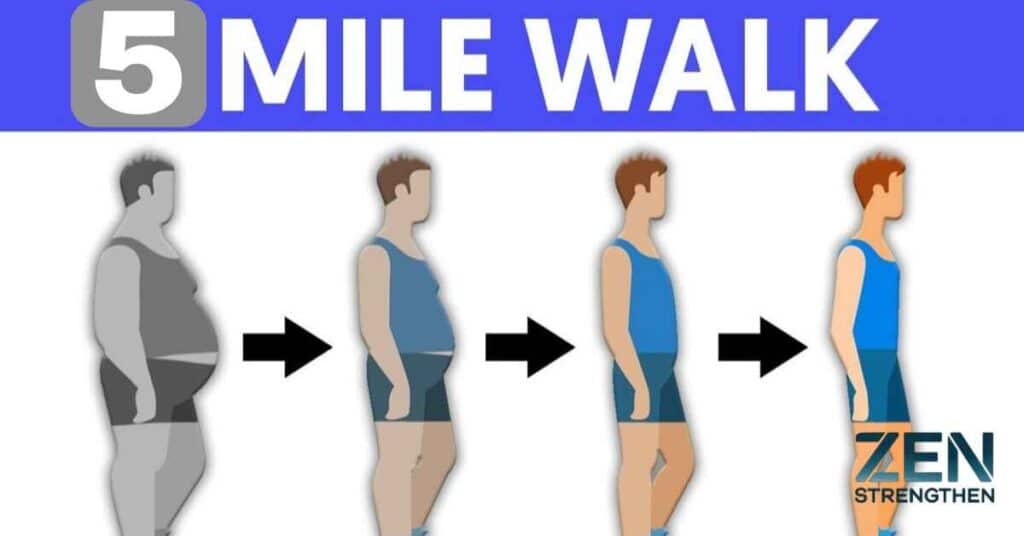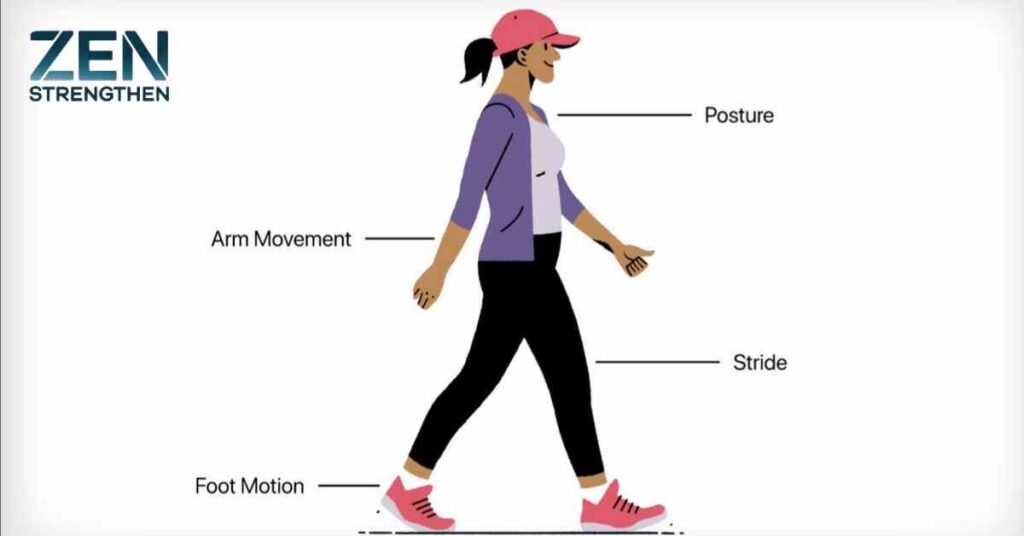Looking to get fit without an intense workout regimen? Walking 5 miles a day could be your perfect solution. Many people face challenges like stress, poor cardiovascular health, and the risk of heart disease, which can feel overwhelming. However, there’s a simple, enjoyable way to address these issues: regular walking.
This easy-to-implement aerobic exercise not only enhances cardiovascular health but also plays a crucial role in heart disease prevention. Picture this: each step you take not only strengthens your heart but also helps melt away stress, leaving you feeling uplifted and rejuvenated. Walking can significantly enhance your mood, making it a fantastic addition to your daily routine.
The Benefits of Walking: More Than Just a Stroll
In this post, we’ll dive into five compelling “benefits of walking 5 miles a day.” From boosting your heart health to providing essential stress relief, you’ll discover how this simple activity can transform your journey toward fitness and well-being. Let’s take that first step together! Walking benefits extend far beyond just getting you from point A to point B.
Why 5 Miles Matters

Five miles might sound like a lot, but it’s an achievable goal that can yield impressive results. Here’s why this distance is the sweet spot for many walkers:
- It’s long enough to provide significant health benefits
- It’s achievable for most people with some practice
- It burns a substantial number of calories
- It can be completed in a reasonable amount of time
“All truly great thoughts are conceived while walking.” – Friedrich Nietzsche
Health Benefits of Walking 5 Miles Daily
The health benefits of “walking 5 miles” a day are numerous and far-reaching. Let’s explore how this simple activity can revolutionize your well-being:
Cardiovascular Health: Your Heart’s Best Friend
Walking is a fantastic way to boost your cardiovascular health. Regular 5-mile walks can:
- Lower blood pressure
- Reduce risk of heart disease
- Improve cholesterol levels
- Enhance circulation
Weight Management: Walk Off Those Extra Pounds
Walking 5 miles a day can be a powerful tool for weight management. Here’s why:
- Burns approximately 500-600 calories (varies by weight and pace)
- Boosts metabolism, even after you’ve finished walking
- Helps maintain muscle mass while losing fat
Mental Health: A Step Towards Happiness
The benefits of walking extend beyond physical health. It’s also a potent mood-booster:
- Reduces symptoms of anxiety and depression
- Improves self-esteem
- Enhances cognitive function
- Reduces stress levels
“Walking is man’s best medicine.” – Hippocrates
Joint Health: Low-Impact, High Reward
Unlike high-impact activities, walking is gentle on your joints while still providing significant benefits:
- Strengthens muscles around joints
- Improves flexibility
- Reduces risk of osteoarthritis
- Can alleviate existing joint pain
Sleep Quality: Walk Your Way to Better Rest
Struggling with sleep? A daily 5-mile walk might be the solution:
- Helps regulate sleep patterns
- Improves sleep quality
- Increases sleep duration
Immune System: A Natural Boost
Regular walking can give your immune system a much-needed boost:
- Increases production of white blood cells
- Enhances overall immune function
- May reduce frequency of common illnesses
Nutrition for 5-Mile Walkers

Proper nutrition is crucial to support your 5-mile walking habit. Here are some tips:
Pre-Walk Fueling Strategies
- Eat a light meal 1-2 hours before your walk
- Focus on complex carbohydrates for sustained energy
- Include a small amount of protein to prevent muscle breakdown
Post-Walk Recovery Nutrition
- Consume a mix of carbohydrates and protein within 30 minutes of finishing
- Aim for a 3:1 ratio of carbs to protein
- Consider a smoothie or a small meal like whole grain toast with peanut butter
Hydration Tips for Long Walks
Proper hydration is crucial for any exercise routine, including walking:
- Drink 16-20 ounces of water 2-3 hours before your walk
- Sip water every 15-20 minutes during your walk
- For walks over 90 minutes, consider an electrolyte drink
Breaking Down the Numbers: Steps in 5 Miles
One of the most common questions people ask is, “How many steps per mile are there in a 5-mile walk?” The answer isn’t as straightforward as you might think. Several factors come into play, including your height, stride length, and walking speed.
Average Steps for Walking 5 Miles
| Gender | Average Height | Average Stride Length | Approximate Steps in 5 Miles |
| Women | 5’4″ (162.56 cm) | 2.2 feet (67 cm) | 11,000 – 11,500 |
| Men | 5’9″ (175.26 cm) | 2.5 feet (76 cm) | 10,000 – 10,500 |
Remember, these are averages. Your personal step count may vary based on your unique characteristics.
Factors Affecting Step Count
- Height and stride length: Taller individuals generally have longer strides, resulting in fewer steps per mile.
- Walking speed: A faster pace often leads to longer strides and fewer steps.
- Terrain and incline: Uphill walks typically involve shorter strides, increasing step count.
- Age and fitness level: These can affect your natural stride length and walking efficiency.
Walking vs. Running: A Step Comparison
When it comes to running vs walking, the step count difference might surprise you:
- Walking 5 miles: Approximately 10,000 – 12,500 steps
- Running 5 miles: Approximately 6,000 – 8,000 steps
Runners take fewer steps because their stride length increases significantly when running.
The Science Behind Stride Length
Understanding your stride length is key to accurately estimating your step count. Here’s how to measure it:
- Mark a starting point on the ground
- Take 10 natural steps
- Mark your ending point
- Measure the distance between start and end points
- Divide this distance by 10 to get your average stride length
Once you know your stride length, you can use this formula to estimate your steps:
Copy
Steps = (5280 feet per mile / Your stride length in feet) * 5 miles
Many fitness trackers and smartphone apps can help you track your steps accurately. These devices use sophisticated algorithms that account for variations in movement patterns.
Time Investment: How Long Does 5 Miles Take?

The time it takes to walk 5 miles depends largely on your walking speed or average pace. Here’s a breakdown:
| Pace Description | Speed (mph) | Time for 5 Miles |
| Leisurely | 2.0 | 2 hours 30 minutes |
| Average | 3.0 | 1 hour 40 minutes |
| Brisk | 4.0 | 1 hour 15 minutes |
| Power Walking | 5.0 | 1 hour |
For runners, the times can vary greatly based on fitness level:
- Beginner: 50-60 minutes
- Intermediate: 40-50 minutes
- Advanced: 30-40 minutes
Getting Started: Your 5-Mile Walking Plan
Ready to start your 5-mile walking journey? Here’s a comprehensive plan to get you on the right track:
Setting Realistic Goals
Start small and gradually build up to 5 miles. Here’s a sample progression:
| Week | Daily Distance | Weekly Goal |
| 1 | 1 mile | 5 miles |
| 2 | 2 miles | 10 miles |
| 3 | 3 miles | 15 miles |
| 4 | 4 miles | 20 miles |
| 5 | 5 miles | 25 miles |
Choosing the Right Gear
- Proper footwear: Invest in good walking shoes with adequate support
- Comfortable clothing: Opt for moisture-wicking fabrics
- Accessories: Consider a water bottle, sun protection, and a fitness tracker
Warm-Up and Cool-Down Routines
Always start and end your walks with these routines to prevent injury:
Warm-Up (5-10 minutes):
- Gentle walking in place
- Arm circles
- Leg swings
- Ankle rotations
Cool-Down (5-10 minutes):
- Slow walking
- Gentle stretches for calves, hamstrings, and quadriceps
Building Endurance Gradually
- Increase your distance by no more than 10% each week
- Listen to your body and rest when needed
- Incorporate rest days into your routine
Creating Varied Routes
Keep your walks interesting by:
- Exploring different neighborhoods
- Trying out local parks and trails
- Varying between flat terrain and hills
Using Technology to Track Progress
A fitness tracker or smartphone app can help you:
- Monitor your step count
- Track your distance and pace
- Set and achieve goals
Finding Motivation
- Walk with a buddy or join a walking group
- Participate in virtual walking challenges
- Set rewards for reaching milestones
Advanced Techniques for 5-Mile Walkers

Once you’ve mastered the basics, try these techniques to amp up your walking routine:
Interval Training for Walkers
Alternate between periods of brisk walking and recovery:
- 2 minutes at a challenging pace
- 1 minute at a recovery pace
- Repeat for the duration of your walk
Incorporating Hills and Stairs
Add inclines to your route to:
- Increase calorie burn
- Build leg strength
- Improve cardiovascular fitness
Nordic Walking for Full-Body Engagement
Use specially designed poles to:
- Engage upper body muscles
- Increase calorie burn by up to 20%
- Improve posture and balance
Mindfulness and Walking Meditation
Combine your walk with mindfulness practices:
- Focus on your breath
- Observe your surroundings without judgment
- Practice gratitude as you walk
Overcoming Common Challenges
Don’t let obstacles derail your walking routine. Here’s how to tackle common issues:
Dealing with Weather Extremes
- Hot weather: Walk early morning or evening, stay hydrated
- Cold weather: Layer clothing, wear gloves and a hat
- Rainy days: Use waterproof gear or try indoor walking (treadmill or mall walking)
Managing Time Constraints
- Break your walk into shorter sessions throughout the day
- Incorporate walking into your daily routine (e.g., walk to work or during lunch break)
- Wake up earlier to fit in your walk
Staying Motivated Long-Term
- Set new challenges (increase pace, try new routes)
- Track your progress and celebrate milestones
- Join online communities for support and motivation
Addressing Physical Discomfort or Pain
- Ensure you’re wearing proper footwear
- Gradually increase your distance to allow your body to adapt
- Consult a healthcare professional if pain persists
Beyond 5 Miles: Progressing Your Walking Journey

Once you’ve mastered 5 miles, you might be ready for new challenges:
Increasing Distance and Intensity Safely
- Add 0.5 miles to your walk every 2-3 weeks
- Incorporate speed walking or jogging intervals
- Try walking events like half-marathons or marathons
Combining Walking with Other Exercises
- Add strength training exercises 2-3 times a week
- Try yoga or Pilates for flexibility and core strength
- Incorporate balance exercises to improve stability
Participating in Walking Events and Challenges
- Sign up for charity walks
- Join virtual walking challenges
- Organize a walking event in your community
The Bigger Picture: Daily Step Goals
While 5-mile walks are great, it’s important to stay active throughout the day. Here’s how to integrate more steps into your daily routine:
Understanding Step Recommendations
The often-cited goal of 10,000 daily steps isn’t based on scientific research. However, studies suggest that health benefits increase with each step, up to about 7,500 steps per day.
How 5 Miles Fits into Daily Activity Levels
A 5-mile walk contributes significantly to your daily step count:
- 5 miles ≈ 10,000-12,500 steps
- This meets or exceeds most daily step recommendations
Balancing Structured Walks with Overall Daily Movement
- Aim for your 5-mile walk most days of the week
- On rest days, focus on accumulating steps through daily activities
- Use a step count calculator to track your progress
Conclusion
Walking 5 miles a day is more than just a fitness goal – it’s a lifestyle change that can dramatically improve your health and well-being. From boosting your cardiovascular health and aiding in weight management, to improving your mood and sleep quality, the benefits are truly remarkable.
Remember, the journey of a thousand miles begins with a single step. Start where you are, use what you have, and do what you can. Whether you’re walking for fitness, weight loss, or simply to enjoy the outdoors, each step brings you closer to a healthier, happier you.
So, lace up those shoes, step out the door, and start your 5-mile adventure today. Your body and mind will thank you for it!
FAQs
Can walking 5 miles a day help me lose weight?
Yes, walking 5 miles a day can significantly contribute to weight loss. It burns approximately 500-600 calories, depending on your weight and pace. Combined with a healthy diet, this can create the calorie deficit needed for weight loss.
How does walking compare to other forms of cardio?
Walking is a low-impact form of cardio that’s accessible to most people. While it may not burn as many calories as running or high-intensity interval training, it’s gentler on the joints and can be sustained for longer periods, making it an excellent option for overall health and fitness.
Is it safe to walk 5 miles every day?
For most healthy adults, walking 5 miles daily is safe. However, it’s important to build up to this distance gradually and listen to your body. If you have any health concerns or pre-existing conditions, consult with your healthcare provider before starting a new exercise routine.
How can I make my 5-mile walks more challenging?
You can increase the challenge of your walks by incorporating hills, increasing your pace, adding intervals of speed walking or jogging, or trying Nordic walking. You can also carry light hand weights or wear a weighted vest to increase the intensity.
What should I do if I experience pain while walking?
If you experience pain while walking, it’s important to address it promptly. First, ensure you’re wearing proper footwear and using good walking form. If pain persists, reduce your distance or take a rest day. If the pain continues or worsens, consult with a healthcare professional to rule out any injuries or underlying conditions.
Disclaimer
“This article” is intended for general informational purposes only and does not address individual circumstances. It is not a substitute for professional advice or help and should not be relied on to make decisions of any kind. Any action you take upon the information presented in this article is strictly at your own risk and responsibility!

Jhon Wick is a seasoned writer in the fitness niche, dedicated to sharing expert advice and the latest trends. With a passion for health and wellness, Jhon offers practical tips and inspiration to help readers achieve their fitness goals and stay motivated.







